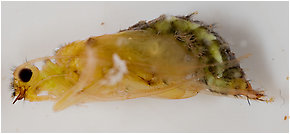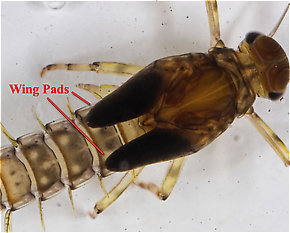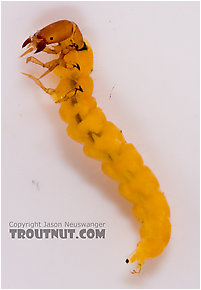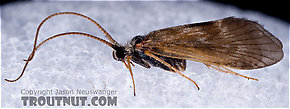Blog & Latest Updates
Fly Fishing Articles
Insects by Common Name


Insect Order Trichoptera (Caddisflies)
Taxonomic Navigation -?-
Kingdom
Animalia (Animals)
» Phylum
Arthropoda (Arthropods)
» Class
Insecta (Insects)
» Order Trichoptera (Caddisflies)
5 families aren't included.
Common Name
| Match | Common Name |
| Caddisflies |
This is page 3 of specimens of Trichoptera. Visit the main Trichoptera page for:
- The behavior and habitat of Trichoptera.
- 55 underwater pictures of Trichoptera.
Pictures of 129 Caddisfly Specimens:
Brachycentrus appalachia (Apple Caddis) Caddisfly Adult View 9 PicturesThe wings of this specimen were pale tan, almost white, when I collected it, and the body was of the lighter "apple green" from which this species gets its common name. Everything turned much darker by the time I got it home and under the camera.
View 9 PicturesThe wings of this specimen were pale tan, almost white, when I collected it, and the body was of the lighter "apple green" from which this species gets its common name. Everything turned much darker by the time I got it home and under the camera.
The wings look even darker in some of these pictures because the background is black and the wings are unusually translucent. You can see that in one of the pictures where the body easily through the wings. They're really a light, translucent gray, which is still far from the pale tan of the same fly when it was freshly emerged.
 View 9 PicturesThe wings of this specimen were pale tan, almost white, when I collected it, and the body was of the lighter "apple green" from which this species gets its common name. Everything turned much darker by the time I got it home and under the camera.
View 9 PicturesThe wings of this specimen were pale tan, almost white, when I collected it, and the body was of the lighter "apple green" from which this species gets its common name. Everything turned much darker by the time I got it home and under the camera.The wings look even darker in some of these pictures because the background is black and the wings are unusually translucent. You can see that in one of the pictures where the body easily through the wings. They're really a light, translucent gray, which is still far from the pale tan of the same fly when it was freshly emerged.
Collected May 15, 2007 from the West Branch of the Delaware River in New York
Added to Troutnut.com by Troutnut on May 18, 2007
Added to Troutnut.com by Troutnut on May 18, 2007
Cheumatopsyche (Little Sister Sedges) Caddisfly Adult View 9 Pictures
View 9 Pictures
 View 9 Pictures
View 9 PicturesCollected September 19, 2006 from Mystery Creek #43 in New York
Added to Troutnut.com by Troutnut on October 4, 2006
Added to Troutnut.com by Troutnut on October 4, 2006
Male Psilotreta labida (Dark Blue Sedge) Caddisfly Adult View 11 Pictures
View 11 Pictures
 View 11 Pictures
View 11 PicturesCollected June 1, 2007 from the West Branch of the Delaware River in New York
Added to Troutnut.com by Troutnut on June 4, 2007
Added to Troutnut.com by Troutnut on June 4, 2007
Hydropsyche (Spotted Sedges) Caddisfly Pupa View 8 PicturesSeveral users have interesting comments in the discussion of this specimen, but this observation by Creno is especially good:
View 8 PicturesSeveral users have interesting comments in the discussion of this specimen, but this observation by Creno is especially good:
 View 8 PicturesSeveral users have interesting comments in the discussion of this specimen, but this observation by Creno is especially good:
View 8 PicturesSeveral users have interesting comments in the discussion of this specimen, but this observation by Creno is especially good:Also, this is what I would call an "immature" pupa. The wingpads of caddis pupae darken to nearly black as the enclosed adults near emerging. The darkening is the developing adult wing inside the pupal wing pad (Wing pad: A protrusion from the thorax of an insect nymph which holds the developing wings. Black wing pads usually indicate that the nymph is nearly ready to emerge into an adult.). The ultimate coloration of the adult wing is not very apparent in most pupal wing pads ( The wing pads on this final instar Baetidae mayfly nymph are extremely dark.Wing pad: A protrusion from the thorax of an insect nymph which holds the developing wings. Black wing pads usually indicate that the nymph is nearly ready to emerge into an adult.) as the majority of the adult wing coloration comes from the color/position of the adult wing hairs and setae (Seta: Little hairs on insects.). But dark pupal wingpads are a good indication that the emergence will occur very soon, likely that day or so, and that the adult parts are sufficiently developed within the pupae to make a species determination from the specimen, particularly if it is a male.
The wing pads on this final instar Baetidae mayfly nymph are extremely dark.Wing pad: A protrusion from the thorax of an insect nymph which holds the developing wings. Black wing pads usually indicate that the nymph is nearly ready to emerge into an adult.) as the majority of the adult wing coloration comes from the color/position of the adult wing hairs and setae (Seta: Little hairs on insects.). But dark pupal wingpads are a good indication that the emergence will occur very soon, likely that day or so, and that the adult parts are sufficiently developed within the pupae to make a species determination from the specimen, particularly if it is a male. The wing pads on this final instar Baetidae mayfly nymph are extremely dark.
The wing pads on this final instar Baetidae mayfly nymph are extremely dark.
Collected May 13, 2007 from the Delaware River in New York
Added to Troutnut.com by Troutnut on May 18, 2007
Added to Troutnut.com by Troutnut on May 18, 2007
Chimarra (Little Black Sedges) Caddisfly Larva View 6 Pictures
View 6 Pictures
 View 6 Pictures
View 6 PicturesCollected March 30, 2007 from Fall Creek in New York
Added to Troutnut.com by Troutnut on April 2, 2007
Added to Troutnut.com by Troutnut on April 2, 2007
Limnephilidae (Northern Caddisflies) Caddisfly Larva View 5 Pictures
View 5 Pictures
 View 5 Pictures
View 5 PicturesCollected March 1, 2004 from unknown in Wisconsin
Added to Troutnut.com by Troutnut on January 25, 2006
Added to Troutnut.com by Troutnut on January 25, 2006
Phryganeidae Caddisfly Larva View 5 PicturesThis "specimen" is actually two caddis larvae fighting each other over a case. The case is a hollow tube; one larva would go in the back end, presumably bite the other, and chase it out. The invader crawled forward into the case while the other one fled, and then it went around to the back and bit the first one. They did this several times, and I recorded it on video.
View 5 PicturesThis "specimen" is actually two caddis larvae fighting each other over a case. The case is a hollow tube; one larva would go in the back end, presumably bite the other, and chase it out. The invader crawled forward into the case while the other one fled, and then it went around to the back and bit the first one. They did this several times, and I recorded it on video.
 View 5 PicturesThis "specimen" is actually two caddis larvae fighting each other over a case. The case is a hollow tube; one larva would go in the back end, presumably bite the other, and chase it out. The invader crawled forward into the case while the other one fled, and then it went around to the back and bit the first one. They did this several times, and I recorded it on video.
View 5 PicturesThis "specimen" is actually two caddis larvae fighting each other over a case. The case is a hollow tube; one larva would go in the back end, presumably bite the other, and chase it out. The invader crawled forward into the case while the other one fled, and then it went around to the back and bit the first one. They did this several times, and I recorded it on video.Collected March 1, 2004 from unknown in Wisconsin
Added to Troutnut.com by Troutnut on January 25, 2006
Added to Troutnut.com by Troutnut on January 25, 2006
Male Mystacides sepulchralis (Black Dancer) Caddisfly Adult View 10 PicturesThis was one of many of its species which were gathered in small, low-flying swarms of about a dozen insects near the alder trees in the afternoon on a small stream.
View 10 PicturesThis was one of many of its species which were gathered in small, low-flying swarms of about a dozen insects near the alder trees in the afternoon on a small stream.
 View 10 PicturesThis was one of many of its species which were gathered in small, low-flying swarms of about a dozen insects near the alder trees in the afternoon on a small stream.
View 10 PicturesThis was one of many of its species which were gathered in small, low-flying swarms of about a dozen insects near the alder trees in the afternoon on a small stream.Collected August 22, 2006 from the West Branch of Owego Creek in New York
Added to Troutnut.com by Troutnut on August 23, 2006
Added to Troutnut.com by Troutnut on August 23, 2006
Brachycentrus appalachia (Apple Caddis) Caddisfly Adult View 5 Pictures
View 5 Pictures
 View 5 Pictures
View 5 PicturesCollected May 7, 2005 from the Beaverkill River in New York
Added to Troutnut.com by Troutnut on May 16, 2006
Added to Troutnut.com by Troutnut on May 16, 2006
Apatania (Early Smoky Wing Sedges) Caddisfly Adult View 7 PicturesThis one actually had a medium tan body when it emerged. By the time I took the picture it was dark as night. I was actually looking through my box of specimens trying to figure out where that tan one I caught disappeared to. Then I realized this is it.
View 7 PicturesThis one actually had a medium tan body when it emerged. By the time I took the picture it was dark as night. I was actually looking through my box of specimens trying to figure out where that tan one I caught disappeared to. Then I realized this is it.
 View 7 PicturesThis one actually had a medium tan body when it emerged. By the time I took the picture it was dark as night. I was actually looking through my box of specimens trying to figure out where that tan one I caught disappeared to. Then I realized this is it.
View 7 PicturesThis one actually had a medium tan body when it emerged. By the time I took the picture it was dark as night. I was actually looking through my box of specimens trying to figure out where that tan one I caught disappeared to. Then I realized this is it.Collected May 15, 2007 from the West Branch of the Delaware River in New York
Added to Troutnut.com by Troutnut on May 18, 2007
Added to Troutnut.com by Troutnut on May 18, 2007
Top 10 Fly Hatches
Top Gift Shop Designs
Eat mayflies.
Top Insect Specimens
Miscellaneous Sites
Troutnut.com is copyright © 2004-2024 Jason
Neuswanger (email Jason). See my FAQ for information about use of my images.
 privacy policy
privacy policy
